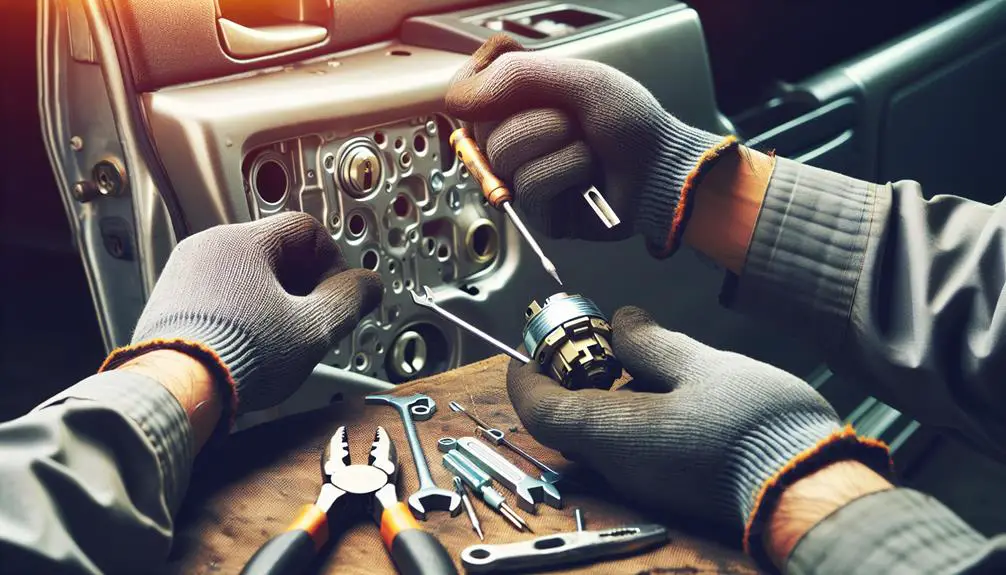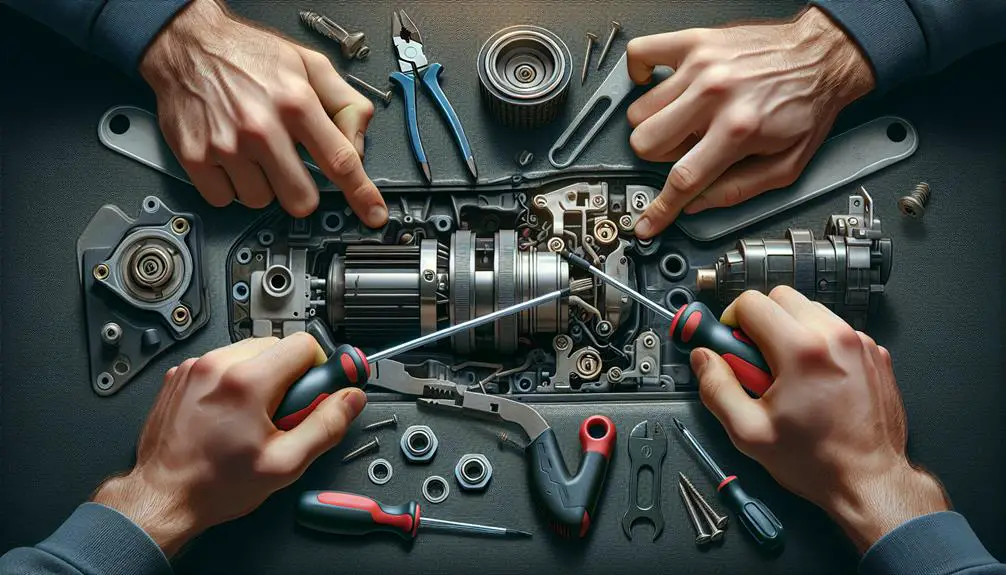If you're having trouble with your Hyundai door lock, there are a few steps you can take to try and repair it yourself.
First, check to see if the lock is simply stuck due to dirt or debris. You can use a can of compressed air to clean out any particles that may be causing the issue.
If that doesn't work, you may need to lubricate the lock mechanism. You can use a silicone-based lubricant to help loosen up any stuck parts. Be sure to avoid using oil-based lubricants as they can attract more dirt and grime over time.
If these steps don't solve the problem, it may be necessary to replace the door lock entirely. You can purchase a new lock from a Hyundai dealership or an auto parts store and follow the manufacturer's instructions for installation.
By following these steps, you can hopefully get your Hyundai door lock working properly again without having to spend a lot of money on professional repairs.
Diagnosing the Problem

Before attempting repairs, it's critical to accurately diagnose the issue with your Hyundai door lock. This involves a systematic inspection of the lock mechanism, electrical connections, and control module. Start by checking for lock misalignment, a common culprit behind malfunctioning door locks. Misalignment can prevent the lock from engaging or disengaging properly, leading to difficulties in locking or opening the door. Make sure that the lock mechanism aligns correctly with the latch on the door frame. Adjustments may be necessary if you notice any discrepancies in alignment.
Next, examine the key for any signs of damage. Key damage can vary from bent shapes to worn teeth, all of which can hinder its ability to operate the lock effectively. If the key doesn't fit into the lock smoothly or fails to turn, this could indicate that the key itself is the issue. In some instances, using a spare key can help you determine if the problem lies with the original key or within the lock mechanism itself.
Through this systematic approach, focusing on lock misalignment and key damage, you'll be able to pinpoint the root cause of your Hyundai door lock issue.
Cleaning and Lubrication
Once you've pinpointed the issue with your Hyundai door lock, it's vital to start the cleaning and lubrication process to guarantee its smooth operation. Initially, gather the proper tools: a quality cleaner suitable for automotive use, a lubricant designed specifically for locks, a soft cloth, and a set of precision screwdrivers. Before proceeding, take necessary safety precautions, such as wearing gloves to protect your skin and making sure your Hyundai is securely parked and off.
Begin by gently removing any debris or dust from the lock mechanism using the soft cloth. Avoid using harsh chemicals or metal tools that could damage the lock's surface. Next, apply the cleaner directly onto the lock, ensuring it penetrates the mechanism thoroughly. This will help dissolve any grime or residue that might be causing the lock to stick or malfunction.
After cleaning, dry the lock mechanism completely with a clean cloth. Then, apply a small amount of lubricant. It's vital to use the correct type of lubricant—preferably one that's silicone-based, as it won't attract dirt or dust, ensuring the lock's long-term smooth operation. Carefully work the lubricant into the lock by gently inserting the key and turning it several times. This systematic approach ensures your Hyundai's door lock remains in ideal condition.
Replacing the Cylinder

After ensuring your Hyundai's door lock is clean and well-lubricated, you may find that the lock cylinder itself needs replacement due to wear or damage. The process requires precision and attention to detail, starting with the removal of the door panel to access the lock assembly. Once exposed, disconnect any electrical connectors and carefully remove the retaining clip or screws holding the cylinder in place.
Before installing the new cylinder, it's vital to make sure it matches your Hyundai's key. This step, known as key matching or cylinder coding, involves adjusting the new cylinder's pins to align with your existing key's unique pattern. If you're not experienced with cylinder coding, consider having this task performed by a professional to avoid compromising your lock's security.
With the new cylinder coded to your key, insert it into the door lock assembly. Make sure it's seated properly before reattaching the retaining clip or screws. Reconnect any electrical connectors, if applicable, and carefully reassemble the door panel.
Test the lock with your key to confirm proper function. If the cylinder turns smoothly and the door locks and locks without issue, the replacement was successful. Remember, regular maintenance and prompt repair of your Hyundai's door lock can prevent future problems.
Fixing Electrical Issues
If you're facing issues with your Hyundai's door lock not responding, it's likely due to an electrical problem that requires a systematic troubleshooting approach. Electrical glitches can prevent your door lock from functioning correctly, but with careful attention to detail, you can identify and fix the problem. Here's how:
- Fuse Replacement: Start by checking the fuse associated with the door lock system. A blown fuse is a common culprit behind electrical failures. Locate the fuse box, usually found under the dashboard or near the engine bay, and find the fuse diagram in your Hyundai's manual. Replace any blown fuses with new ones of the same amperage.
- Wiring Inspection: Inspect the wiring leading to and from the door lock actuator. Look for any signs of wear, tear, or corrosion that could interrupt the electrical signal.
- Connector Check: Ensure all electrical connectors are firmly attached and free from corrosion. Loose or corroded connections can disrupt the electrical circuit.
- Voltage Test: Use a multimeter to check for voltage at the door lock actuator. Lack of voltage indicates a break in the circuit somewhere between the fuse box and the door lock.
- Actuator Examination: If the electrical supply is consistent but the lock still fails to respond, the actuator itself might be faulty. Consider testing it with a known-good unit for comparison.
Reassembling the Door Lock

Having diagnosed and addressed any electrical issues, it's time to focus on reassembling your Hyundai's door lock mechanism with precision. Initially, make sure that all components are clean and in good working condition before you start the reassembly process. This involves carefully placing the actuator back into its designated slot within the door panel. Make sure it's properly aligned to avoid any operational glitches later on.
Next, reattach the connecting rods to the actuator. These rods are important for the translation of the electrical signal into mechanical action, enabling the lock to engage and disengage. It's important that these rods are connected accurately to ensure seamless operation.
Now, turn your attention to the door alignment and hinge adjustments. These steps are critical in making sure that the door closes and locks smoothly. Incorrect alignment can lead to uneven wear on the lock mechanism and ultimately, its failure. Check the door's alignment by closing it gently and observing any misalignments. If necessary, make slight adjustments to the hinges until the door aligns perfectly with the frame.
Conclusion
To sum up, you've successfully navigated the complexities of repairing your Hyundai door lock. By meticulously diagnosing the issue, applying precise cleaning and lubrication techniques, and adeptly handling cylinder replacement or electrical fixes, you've restored peak function.
Reassembling the door lock with precision guarantees longevity and reliability. Your methodical approach not only saves you time and money but also enriches your comprehension of automotive locking mechanisms.
Keep this knowledge handy for future maintenance and repairs.